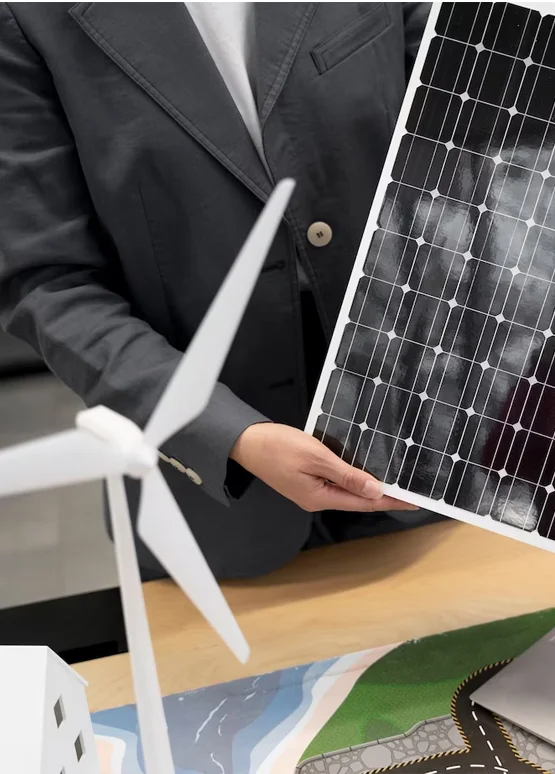Solar Energy Management System: Solar energy, clean and abundant, is emerging as a favorite among alternative energy sources. A Solar Energy Management System (SEMS) is pivotal in efficiently harvesting and utilizing this energy.
This comprehensive guide (Solar Energy Management System) will take you through the intricacies of a Solar Energy Management System, explaining how it functions, its components, benefits, and much more. Whether you’re a business looking to make the transition to renewable energy or an individual wanting to make a difference, this guide will equip you with the knowledge you need.
1- Solar Energy Management System Introduction
What is a solar energy management system?
A solar energy management system is a comprehensive setup that enables the efficient generation, monitoring, and utilization of solar energy. It involves an array of components including solar panels, inverters, batteries, and monitoring systems. One of the key elements in modern solar energy management is the use of advanced monitoring systems like Retgen, which can significantly improve the efficiency and reliability of solar energy generation.
Importance and benefits of solar energy management systems
The importance of solar energy management systems lies in their ability to harness renewable energy, reduce electricity costs, and lessen the environmental impact. They are essential for optimizing the performance of solar panels, ensuring that energy generation meets consumption needs, and maximizing return on investment. With Retgen’s cloud-based architecture, for instance, users can easily track and manage renewable energy plants remotely, leading to greater scalability and flexibility.
2- Understanding Solar Energy
Explaining solar energy generation
Solar energy generation involves converting sunlight into electricity. This is typically achieved through the use of photovoltaic cells which generate an electrical current when exposed to sunlight. Solar panels are made up of these cells and are installed in locations with optimal sunlight exposure.
How solar panels work
Solar panels work by allowing photons from sunlight to knock electrons free from atoms, generating an electrical current. This direct current (DC) is then converted into alternating current (AC) by an inverter, making it usable for household appliances and the electrical grid.
Types of solar energy systems
There are mainly three types of solar energy systems: grid-tied, off-grid, and hybrid systems. Grid-tied systems are connected to the electrical grid, allowing for the excess energy to be fed back into the grid. Off-grid systems are standalone and typically include batteries to store the solar energy. Hybrid systems combine elements of both.
3- Components of a Solar Energy Management System
Solar panels
Solar panels are the fundamental component for capturing sunlight and converting it into electricity. They can be mounted on roofs or other structures.
Photovoltaic (PV) panels
Photovoltaic panels are made up of photovoltaic cells, which generate electrical power by using sunlight.
Solar thermal panels
Solar thermal panels are used for heating purposes by absorbing sunlight to heat a fluid which can then be used to produce steam.
Inverter
Inverters are critical components that convert DC produced by solar panels into AC which is used by most appliances and can be fed into the grid.
Batteries
Batteries are used mainly in off-grid systems to store excess energy that can be used when sunlight is not available.
Charge controller
A charge controller manages the charging and discharging of the battery, protecting it from overcharging and over-discharging.
Monitoring and control systems
Monitoring and control systems, such as Retgen, allow users to track, analyze, and manage the performance of solar energy systems remotely. Retgen is particularly advantageous as it supports integration with different brands and models of inverters, and does not require additional hardware.
4- Designing a Solar Energy Management System
Assessing energy needs and consumption
Before designing a solar energy management system, it’s crucial to assess your energy needs. This includes understanding how much energy your home or business consumes and what portion of that you want to be covered by solar energy.
Determining the size and capacity of the system
The size and capacity of the system are dependent on your energy needs. The number and size of solar panels, as well as the capacity of batteries and inverters, need to be determined accordingly.
Placement and orientation of solar panels
Solar panels should be placed in a location with maximum sunlight exposure, and oriented to optimize the capture of solar rays.
Sizing and selection of batteries
If the system is off-grid, the sizing and selection of batteries are crucial for storing electricity. The capacity should be sufficient to store enough energy for usage during non-sunny hours or days.
Considerations for grid-tied vs. off-grid systems
Considerations such as availability of grid, preferences for independence from the grid, and financial incentives should be taken into account when deciding between grid-tied or off-grid systems.
In the design phase, it is also advisable to consider integrating an advanced monitoring and management system like Retgen, which can further enhance the efficiency and reliability of your solar energy system. Through cloud-based tracking, Retgen can provide invaluable insights into the system’s performance and allow for timely maintenance and optimization.
5- Installing a Solar Energy Management System
Site preparation and evaluation
Before installing the solar energy management system, it is essential to prepare the site. This includes evaluating the site to ensure it has sufficient sunlight exposure, and checking for any obstructions or shading. The structural integrity of roofs or other structures where the panels will be mounted should also be assessed.
Mounting solar panels
The solar panels must be securely mounted to withstand various weather conditions. There are various mounting systems available, such as roof mounts, ground mounts, and pole mounts.
Wiring and electrical connections
Proper wiring and electrical connections are crucial for the safe and efficient operation of the solar energy management system. This should be done by a qualified electrician, following all local regulations and codes.
Installing inverters and batteries
Inverters should be installed in a location that minimizes energy loss and is protected from weather elements. For off-grid systems, batteries must be installed in a well-ventilated and secure space.
Safety considerations during installation
During installation, safety is paramount. This includes ensuring that all electrical connections are safe, using proper protective equipment, and following best practices to prevent accidents
6- Maximizing Efficiency and Performance
Proper maintenance and cleaning of solar panels
To maximize efficiency, it’s important to regularly maintain and clean solar panels, as dirt and debris can reduce their effectiveness.
Monitoring energy production and consumption
Monitoring systems like Retgen enable users to track energy production and consumption in real-time, helping to identify areas for optimization and increase efficiency.
Optimizing battery performance
For off-grid systems, it’s essential to monitor and optimize battery performance to ensure they are charged and discharged in a way that maximizes their lifespan and effectiveness.
Troubleshooting common issues
Being proactive in troubleshooting issues, such as drops in energy production, can help maintain optimal performance.
Upgrading and expanding the system
As energy needs change, the system may need to be upgraded or expanded. This includes adding more panels, upgrading inverters, or expanding battery storage.

7- Integrating with the Power Grid
Grid-connected solar energy systems
Grid-connected systems are linked to the local electricity grid, allowing excess energy to be sold back to the utility company.
Net metering
Net metering allows consumers to receive credit for the excess energy they feed into the grid, which can be used to offset electricity costs when solar production is low.
Feed-in tariffs
Some regions offer feed-in tariffs, where the utility company pays the solar system owner a premium rate for the electricity they generate and feed into the grid.
Grid interaction and synchronization
It is important for the solar system to be synchronized with the grid to ensure a steady and reliable power supply.
Benefits of grid integration
Grid integration can provide backup power, reduce electricity bills, and allow for revenue generation through net metering or feed-in tariffs.
Policies and regulations related to grid integration
It is important to be aware of local policies and regulations regarding grid integration, as these can affect feasibility and financial considerations.
8- Financial Considerations
Cost analysis of solar energy management systems
Before installing a solar energy management system, a thorough cost analysis should be conducted. This includes the costs of components, installation, maintenance, and potential savings or revenue from energy production.
Return on investment (ROI) and payback period
Calculating the ROI and understanding the payback period is crucial in assessing the financial viability of the solar energy management system.
Incentives and subsidies for solar energy systems
Various incentives and subsidies may be available to reduce the initial costs of installing solar systems. Researching and availing these can significantly affect financial considerations.
Financing options and available grants
In addition to incentives and subsidies, various financing options such as loans, leases, and grants might be available to help offset the initial costs.
Evaluating long-term cost savings
When considering the financial aspects, it’s important to look at long-term savings. Although the initial investment can be significant, solar energy can lead to substantial savings over time.
In all these steps, leveraging a partner like Retgen can be advantageous. With its advanced monitoring and analytics capabilities, Retgen can help you ensure that your solar energy management system is optimized for maximum efficiency and returns.
9- Environmental Impact of Solar Energy Management Systems
Reduced carbon footprint
One of the most significant benefits of solar energy management systems is the reduction in carbon footprint. By utilizing solar energy, which is a clean and renewable source, emissions of greenhouse gases are significantly reduced compared to traditional fossil fuel-based sources.
Clean and renewable energy source
Solar energy is inexhaustible and causes no pollution during generation. This makes it a sustainable and environmentally friendly alternative to conventional energy sources.
Impact on local ecosystems
Although solar energy is largely beneficial, it’s also important to consider the impact on local ecosystems. Large solar farms, for example, can affect local habitats and need to be planned carefully to mitigate these effects.
Lifecycle assessment of solar panels and components
Evaluating the environmental impact of solar panels and components throughout their lifecycle, including production, use, and disposal, is crucial in understanding the full environmental benefits and drawbacks.
10- Case Studies and Success Stories
Real-world examples of solar energy management systems
There are countless success stories and case studies of businesses, individuals, and communities effectively using solar energy management systems. These examples often showcase the practical benefits and potential challenges faced.
Success stories of businesses and individuals adopting solar energy
Success stories can provide insights into the real-world applications of solar energy. For instance, a business that significantly reduced its energy costs and carbon footprint by adopting a solar energy management system can serve as inspiration.
Lessons learned and best practices from case studies
Case studies can also offer valuable lessons learned and best practices that can be applied by those looking to adopt solar energy management systems.
11- Conclusion Solar Energy Management System
Recap of the importance and benefits of solar energy management systems
In conclusion, solar energy management systems are critical for a sustainable future. They not only reduce carbon emissions but also offer cost savings and energy independence. With advancements in technology, solar systems have become more efficient and accessible.
Encouragement to explore solar energy as a sustainable solution
It is encouraged for individuals, businesses, and communities to explore solar energy as a sustainable solution to meet energy needs. Companies like Retgen can provide the necessary tools and insights to effectively implement and manage these systems.

12- Future Trends and Innovations
Emerging technologies in solar energy management
The solar industry is constantly evolving with new technologies such as perovskite solar cells, which have the potential to significantly increase the efficiency of solar panels.
Integration with smart home systems
Integration of solar energy management systems with smart home technologies can lead to greater energy efficiency and ease of use. For example, using excess solar energy to power smart appliances during peak production times.
Advancements in energy storage solutions
As energy storage technology continues to advance, new solutions are emerging that allow for more efficient and cost-effective storage of solar energy.
Potential for solar energy in transportation and industrial sectors
Solar energy is not just for homes and businesses; there is growing potential for its use in transportation and industrial sectors. This includes solar-powered electric vehicles and using solar energy for manufacturing processes.
Glossary
- Solar Panels: Devices that convert light from the sun into electricity.
- Photovoltaic (PV) Panels: A type of solar panel that generates electricity by using sunlight to cause a reaction between different materials in the cells.
- Solar Thermal Panels: Solar panels that use sunlight to heat a fluid, which can then be used for space heating or hot water.
- Inverter: An electrical device that converts direct current (DC) to alternating current (AC); used in solar systems to convert the electricity generated by the solar panels for use in homes and businesses.
- Charge Controller: A device that controls the charge going into and coming out of the batteries in a solar energy system, protecting the batteries from overcharging.
- Grid-tied System: A solar energy system that is connected to the local electric grid.
- Off-grid System: A solar energy system that operates independently of the local electric grid.
- Net Metering: A billing system where the owner of a solar energy system gets credit for the electricity they add to the grid.
- Feed-in Tariffs: Payments to ordinary energy users for the renewable electricity they generate.

References
- U.S. Energy Information Administration. Solar Explained.
- National Renewable Energy Laboratory. Photovoltaic Research.
- Solar Energy Industries Association. Solar Industry Research Data.
- International Renewable Energy Agency. Renewable Energy Technologies.
- Retgen Company Website. Solar Energy Management Systems.
Additional Resources
Recommended books:
- “Solar Electricity Handbook” by Michael Boxwell
- “Install Your Own Solar Panels” by Joe Burdick and Philip Schmidt
- “Renewable Energy: Power for a Sustainable Future” by Stephen Peake
Recommended websites:
- Solar Energy Industries Association (SEIA) – www.seia.org
- National Renewable Energy Laboratory (NREL) – www.nrel.gov
- Retgen – Solar Management System – https://retgen.com/en/solar-management-system/
Recommended resources for further information:
- “Solar Energy International” – Online courses and training in solar energy.
- “DSIRE” (Database of State Incentives for Renewables & Efficiency) – A comprehensive source of information on incentives and policies that support renewables and energy efficiency in the United States.
- “International Solar Energy Society” – A global organization aimed at promoting the adoption of renewable energy worldwide.



